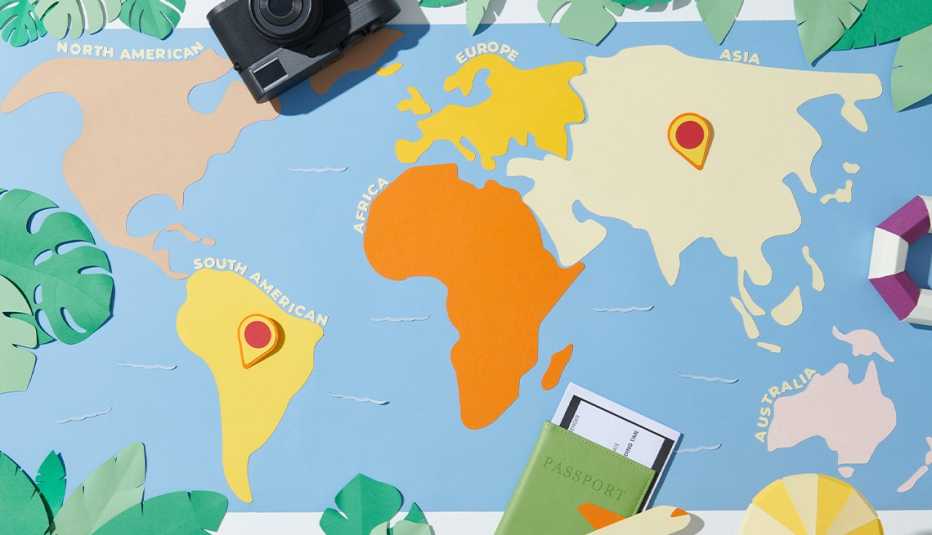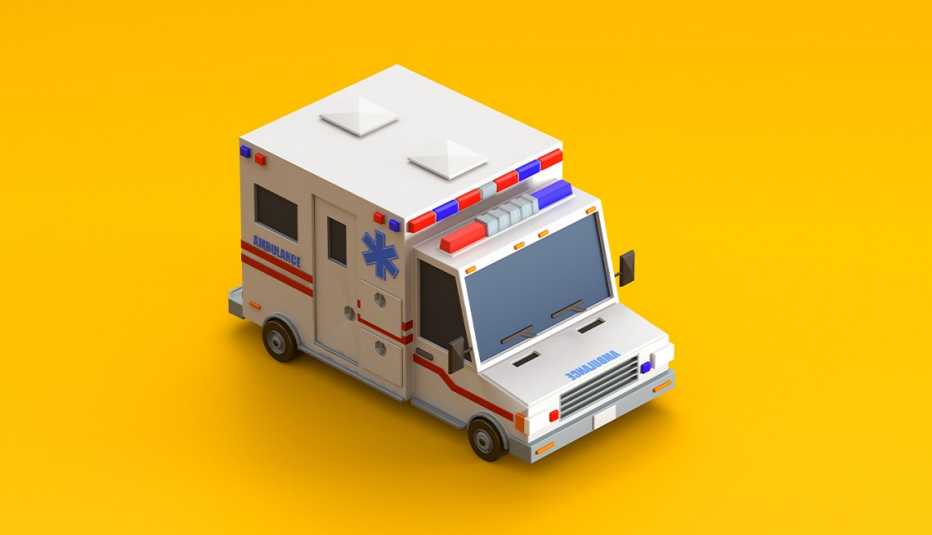AARP Hearing Center


Craving an adventure? You’re not the only one. According to a new AARP survey on travel, a majority of adults (62 percent) 50 and older plan to take at least one leisure trip in 2023 — and most will take three or four trips. International travel is also booming — Europe remains the most popular international destination, followed by Latin America and the Caribbean, according to the survey.
Although a globe-trotting spike could increase travel hiccups — including lost luggage and flight delays — it’s no reason to postpone your bucket-list trip. This comprehensive guide will help prepare you for every stage of your trip and includes curated tips for packing, avoiding common travel mishaps and where to go to beat the crowds.


PLANNING
1. Research your trip
Sometimes, planning your trip can be a bit overwhelming. Start by reading updated guide books, exploring prominent travel sites and following travel bloggers on social media. You can even reach out to bloggers who have recently visited an area and ask specific questions. Check out our section below for ideas for international destinations. For lodging, make sure you find legitimate sites for hotels and other vacation rentals. And start to look for deals far ahead of time — some hotels will offer discounts on gift cards during the holidays, which will come in handy on your summer trip. For transportation, research whether there are taxis or other forms of transportation if you’re not renting a vehicle. Often you’ll find traveler discounts or deals on multiday passes for trains if you book in advance.
2. Get your passport
Passports are generally valid for 10 years, and travelers are often surprised they need to renew. If yours is a year away from expiring, it’s a good idea to renew (and some countries won’t allow entry if a passport expires within six months). If yours is expired, you can expect a wait of up to 13 weeks for a new one, according to the U.S. State Department, the federal agency that issues the documents. If you’ve never had one, the wait may be even longer. Even if you’re willing to pay a fee to have it expedited, you’re still looking at about nine weeks. Learn more (and bookmark the site on devices you’re bringing) on the State Department’s website, travel.state.gov. It’s best to make a copy of your passport and leave the original in a hotel safe while you are out and about exploring.
3. Plan for your reentry
Consider downloading the app Mobile Passport. It’s authorized by U.S. Customs and Border Protection and allows U.S. and Canadian citizens to bypass the regular winding lines at customs for faster processing. By answering most of the customs questions before you even get to the customs officer, you’ll spend less time in line. Download the app here.
4. Search for low-cost fares
If you’re itching to explore, but you’re not sure where, let flight deals be your guide. For Germany-based travel journalist Summer Rylander, who takes an annual overseas trip with her husband each winter, that means brainstorming what she wants out of the getaway — say, relaxation or adventure — then building backward from there via low-cost fares. “We let flight prices, and our mood, determine where we go,” she says. Check out our Smart Guide to Air Travel for more money-saving tips.
5. Alerting your credit card company
Most credit card companies do not need to be alerted that you’re traveling overseas. If you’re not sure, call your company or visit its website to learn more. You can also check if setting travel alerts is an option. Make sure your contact information is up-to-date and consider downloading the card’s app to have on hand in case you need to report fraud or freeze your card.
6. How to bring medications
If you need to bring certain medications with you, keep in mind that each country has its own laws on what’s allowed. According to the Centers for Disease Control and Prevention, common medications such as birth control, Adderall and Benadryl may be unlicensed or considered controlled substances in other countries and vice versa. If you are caught with medication considered unlicensed, authorities could confiscate it — or you could face penalties, including jail or prison time. According to the CDC’s website, you should “check with your destination’s embassy and embassies of countries that you have layovers in to make sure your medicines are permitted.” If a medication you need is not permitted, talk to your health care provider about providing an alternative or a letter explaining your condition and treatment plan. For more information, check out the CDC’s page on travel and medications. You can also check your airline’s website to see whether flying with certain medications, such as Adderall, is prohibited. Check to see if you’re allowed to bring over-the-counter anti-nausea, stomach upset and pain relief medication, just in case.
7. Get destination-specific vaccines, medicines and information
At least one month before you leave, make an appointment with your health care provider for destination-specific vaccines, medicines and information. You can also do a pretravel physical. Your provider can review your medications to see whether anything needs to be adjusted and offer advice on where to best store them. If you’re going to be gone longer than 30 days, inquire about getting enough medication for your trip — most insurance companies only cover a month’s worth.
8. Consider a medical evacuation membership
Many travel insurance plans come with medical evacuation, but Stan Sandberg, cofounder of insurance comparison site TravelInsurance.com, suggests separate medical evacuation membership programs, such as MedJet, Global Rescue or Covac Global for reassurance. Evacuation is standard in a travel insurance plan, but a membership will get you to your preferred hospital. “If you had an emergency overseas and you’re admitted to a hospital, a MedJet plan is going to take you and bring you back to the hospital of your choice in your home state,” Sandberg says. “There are no interim steps. In a travel insurance plan, if you’re in a location that does not have adequate medical facilities, they will evacuate you to the nearest location that will treat you.”
9. Consider group or guided trips
You don’t have to pursue your dream trips alone. “The advantage of small-group trips is safety in numbers,” says Tami Al-Hazzá, cofounder of Femscape Sojourns, which runs boutique group trips for women around the world. “You also don’t have to think about booking anything or dealing with transportation; it’s all planned for you.” Even better? You could make lifelong friends. “It’s an opportunity to share experiences with others,” Al-Hazzá says. For more tips, read our Smart Guide to Solo Travel.
10. Brush up on local phrases
You don’t have to learn a new language before your trip, but if you’re traveling to a country where English is not one of the spoken languages, learning a few key phrases will go a long way. “I think every traveler should know at least the basics, such as ‘hi,’ ‘how are you,’ and questions about food,” Al-Hazzá says. “It really makes a difference to the locals when you try. They’ll be friendlier and more responsive to you.”
Use apps such as Duolingo, Babbel or Drops to help you feel more comfortable and confident with phrasing and pronunciation. And most iPhones come equipped with a Translate app, while the Google Translate app works on Androids and iPhones.
11. Get local currency through your bank
Arrive ready to hit the ground running with a currency supply secured pre-trip. “Most major banks in the U.S. will order foreign currency for their customers free of charge,” says travel journalist Hillary Richard. To order, call your bank and request the amount and currency and familiarize yourself with the exchange rate. It’s best to do this at least a few weeks in advance. “You can usually deposit whatever is left back into your account once you’re home,” Richard says. You can exchange currency at most airports as well. It’s also a good idea to look up what the tipping customs are where you’ll be traveling.
12. Enroll in Global Entry
Be one of the enviable travelers who gets to skip the customs queue when you arrive back in the U.S. by enrolling in Global Entry, which comes with TSA Precheck. “No one wants to wait in an hour-long customs line after getting off a long international flight,” says Alisa Cohen, founder of boutique travel agency the Luxe Traveler Club. “With Global Entry, it can take as little as minutes to be able to clear customs.” Given the renewed zest for international travel, the Global Entry application process is experiencing backlogs (four to six months). If you have a trip on the horizon, apply for Global Entry online as soon as possible.
13. Enroll in STEP
Enroll in the free Smart Traveler Enrollment Program (STEP) to register your trip with the nearest U.S. Embassy or consulate. You’ll also get security updates and alerts. Enroll here.
14. Get a visa
Some international destinations require visas. Check travel.state.gov to see if your dream destination requires one, and, if so, what the application process looks like. In some cases, you’ll obtain the visa upon arrival. In others, you need to mail your application with your passport in advance. If you’d rather leave the job up to someone else, look into hiring a visa service such as CIBT Visas, VisaHQ, or Atlas Visa Services. Although the process can cost hundreds of dollars, these organizations take care of the logistics and ensure your application meets even the pickiest of requirements.
15. Download helpful apps
When traveling overseas, many cellular phone plans can charge high international rates for texting, so research what your particular plan covers. Some less expensive alternative communication apps include WhatsApp, Viber or WeChat — have friends and family members download the same app to keep in touch. These apps use Wi-Fi or your phone’s internet connection to send messages, photos and video. In addition, download your airline’s apps to get updated flight information, check in and have the option to purchase Wi-Fi and meals.


INSURANCE CONSIDERATIONS
16. Get trip insurance
Logistics abound when it comes to international travel. All too often, these logistics can go awry due to an illness, lost luggage or missed flight connections. With a well-researched trip insurance plan, you’ll be ready for the mishaps sans stress. Trip insurance is even more important on overseas excursions. “With international travel, you’re likely going to have an expensive trip, and you’re maybe planning further in advance, which leaves you open to the possibility of things happening between the time you buy your trip and the departure date,” Sandberg says. “Then, depending on the destination, you may not have the type of medical system or hospitals you need in the event of an emergency.”
17. Know what your insurance covers
You may think your health insurance will cover you abroad, but Sandberg recommends reading your plan thoroughly. “For senior travelers who may be on Medicare and retirees, the standard medical coverage does not provide coverage when you leave the U.S.,” he says. “Travel insurance becomes a way to put coverage in place temporarily while you’re traveling outside the country.” Though you can enhance a Medicare plan to include international options, Sandberg says, it’s not cost-effective if you’re only taking one or two trips per year.
18. Travel insurance and preexisting conditions
Getting travel insurance to cover your preexisting condition takes a bit of legwork — but it’s not impossible. “Spend a little extra time reviewing the terms of a plan, or get on the phone with a plan representative,” Sandberg says.
19. Should you use your credit card’s insurance?
Many premium credit cards come with travel insurance, but it’s important to know when to use the offering and when it won’t suffice. For example, credit card insurance can work well for covering a rental car abroad, but Sandberg says it’s typically not the best option for your health or covering an entire trip, especially abroad. “The travel insurance offering in a credit card is going to be a slimmed-down version of coverage you could find elsewhere,” he says. “It will have more exclusions and a more limited set of covered reasons.”






































































More AARP Smart Guides
AARP Members Only Access
Enjoy special content just for AARP members, including full-length films and books, AARP Smart Guides, celebrity Q&As, quizzes, tutorials and classesHow to Find the Best Vacation Rental
28 tips on planning — and enjoying — time away from home
Travel With Confidence — Alone
AARP Smart Guide to Solo Travel shares 23 tips on making a successful trip by yourself
Let Our AARP Smart Guide on Air Travel Lead the Way
Before you book your ticket, learn how to make the trip almost as good as the arrival